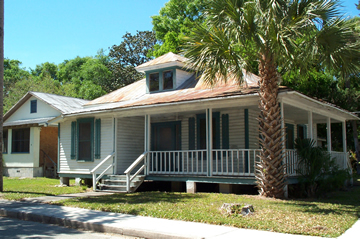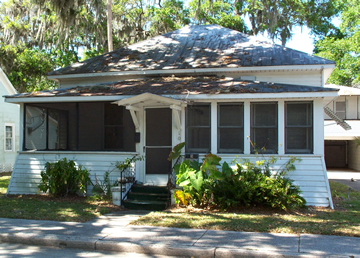Threatened Structures
Threatened Features
La Punta Community
Mission Archeological Site
The
City’s Civil Rights
Landmarks
Threatened Districts
 |
 |
Plans to remove or demolish the historic houses on Alfred and Genoply may cause
the adjacent Nelmar Terrace neighborhood of North City to endure a negative ripple
effect. Florida School for the Deaf and Blind, a state institution, proposes
to eliminate these buildings to make way for a dormitory along San Marco Avenue
and for future, yet-to-be defined needs on the remaining lots.
The historic houses are located over an entire city block and are more than a century old. Two of the houses were part of a farm dating from the late 1880s that provided fresh flowers to the Flagler era hotels. The “younger” houses date from the 1920s. These houses represent a style now known as “frame vernacular” that denotes a sophisticated informal style, usually built by local tradesmen without formal plans. Typically, builders of this architectural style based construction upon other buildings that they observed around them and upon their hands-on experience. The timber used to build these structures is today either unavailable or prohibitively expensive.
The State of Florida Division of Historical Resources has review authority over state agency’s actions affecting historic properties. It has weighed in, saying the houses should be relocated rather than demolished. At the same time the City’s Historic Architectural Review Board issued orders to delay the school’s demolition plans for 12 months. It appears the School now intends to relocate the structures off site and build historic-looking houses where the truly historic houses now stand. Although they might resemble the existing houses, the new buildings would have to meet modern safety codes for students. In the end such required adaptations normally alter proportions and make the buildings appear not to be truly historic.
So, what will happen to the historic houses
and the neighborhood? Is there some solution? Residents of the Nelmar Neighborhood
recommend that the school
return
the properties to their former status—sell the buildings to private residents,
who could revitalize them, retain some affordable housing for the community
and maintain the feel of a neighborhood.
The dilemma of the Alfred-Genoply block plays out throughout our city, state
and nation. Institutions with admirable and beneficial goals, such as churches,
schools and hospitals, grow and expand into residential areas. But as these
institutions attempt to fulfill their missions or provide a service to society,
their expansion
plans potentially may change their neighborhoods and the lives of their neighbors.